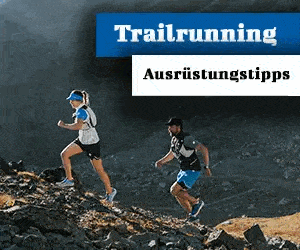Ski touring is great, but requires a lot of knowledge. But not only that. Clever planning is not only important for safety reasons, but also increases the experience many times over. We will show you some essential preparation points and give you tips & tricks for the perfect day in the snow.
A contribution by Fabian Reichle - Bächli Bergsport
Glistening snow, clear air, soothing silence. The rhythmic ascent, the feeling of happiness on the summit and the adrenaline-charged descent. One Skitour is a special nature experience. But despite all the romance and dreamy ideas of a perfect day's skiing, we still find ourselves in partly unpredictable terrain. Dangers are real, even more so in winter than in summer.
In addition to avalanches, there are shorter days, lower temperatures or a lack of infrastructure - for example due to closed mountain huts. It's not always a matter of life and death, but to a large extent a matter of comfort and certainty. That is why meticulous tour planning is a must. We will show you how to organize your ski touring day in such a way that it will be remembered fondly.
The choice of tour: snow and danger of avalanches
If you want to go hell-bent on your ski tour with the aim of climbing summit Y on day X, chances are you will be disappointed. Depending on the situation, routes can become dangerous – more on that later.
However, the snow situation does not necessarily mean a precarious avalanche situation. Planning alternatives is essential so that you can quickly switch to rolling planning at the start or on the way and the original plan can be discarded in favor of an alternative. Some examples experienced by the author himself:
- Danger of avalanches and too much snow in flat terrain: A tour in the foothills of the Alps was hardly mobile due to masses of snow. The fairly safe but flat terrain really slowed me down.
- Too little snow on unfavorable ground: A tour of the Schrattenfluh with a soft, white blanket that only lightly covered the razor-sharp karst rock. The result was totally torn skis.
- Best conditions at the top, spring at the bottom: The Säntis descent was a real treat with fresh powder for a quarter. After that, meadows and several kilometers of ski bumps down to the valley were the order of the day. The fun was gone.
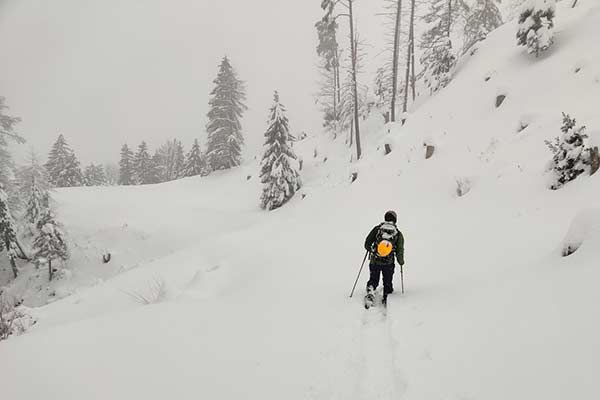
As mentioned at the beginning, there is also the avalanche situation. It is absolutely essential that avalanche bulletins to read and understand. Avalanche knowledge is an elementary part of ski touring. The topic requires its own contribution and is ideally acquired through professional training and repeated regularly. Ultimately, experience counts, but care must always be taken to avoid becoming routine.
An important part of assessing the avalanche danger is not only planning in advance, but also on-site and on the individual slope. The focus is always on the (weather) conditions, terrain and ultimately the people. The SLF provides an overview in practical leaflet format. Anyone who would like to delve deeper into avalanche formation should do so Blog post by freeskier Janic Cathomen heartfelt.
The choice of tour: Difficulty scale
Should it be a leisurely excursion or may there be a pinch of a challenge? Here your own ambitions are decisive, but you should at most be challenged, not overwhelmed. Overexertion and uncertainties are sources of danger. It is important to avoid this if possible.
Ski touring will be after standardized SAC scale rated:
- L (light)
- WS (little difficult)
- ZS (pretty hard)
- S (difficult)
- SS (very difficult)
- AS (extremely difficult)
- EX (extremely difficult)
There are gradations between the grades, which are marked with minus and plus (e.g. WS+ or ZS-). Attention: the rating only applies to the skiing part and is given on the basis of the most difficult part of the route. Other scales such as the UIAA standard for climbing sites are relevant for the ascent. In addition, the grades apply in good conditions.
Approaching is the credo. Better to go one step lower conservatively than overestimate yourself and get stuck on the mountain because the project is simply too difficult.
The tour choice: off-road
A mountain is a mountain is a mountain. No one is like the other and so every ski tour is different. In addition to external factors such as snow and weather, planning also starts with studying maps. These – non-exhaustive – questions are part of the course:
- Is the ascent on a sunny south-facing slope where the snow layer gets baked in the afternoon, or is it a shady north-facing slope with large masses of snow?
- Where are the obvious key points such as steep slopes, cornices or exposed ridges?
- Are there hidden dangers such as flat terrain flanked by potential avalanche slopes?
- How many meters of altitude do you have to conquer and where are the steepest parts?
- At what altitude are we traveling?
- What is the nature of the landscape like? The obvious: forest passages, streams. Hidden: grassy hills or blocked terrain?
- Where are the alternative ascent and descent options?
- For snowboarders: are there long, flat downhill runs? These can be tedious with the board.
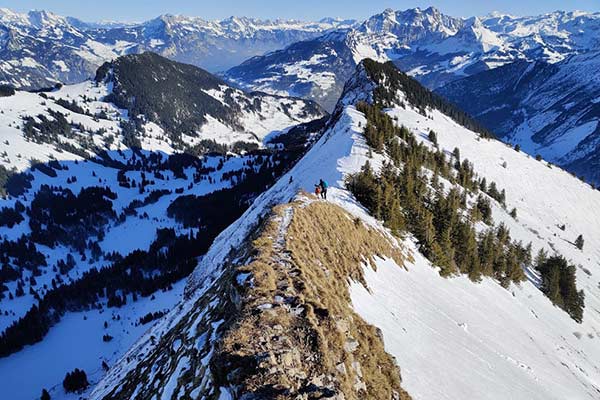
The more you know about a tour in advance, the better. An important indication of the events of a tour are current data and assessments. It is worthwhile to intensively deal with the platform Skitourenguru.ch, on which you will find a summary of important information about a tour. You can find tour reports from other mountaineers at summit book.ch.
Pack the backpack
This is where things get very personal. Of course you take your standard equipment with you, consisting of an avalanche transceiver, shovel and probe. We have what all this includes and how you maintain it in another post dealt with. You will also find what belongs in a backpack for ski touring and freeriding on our blog.
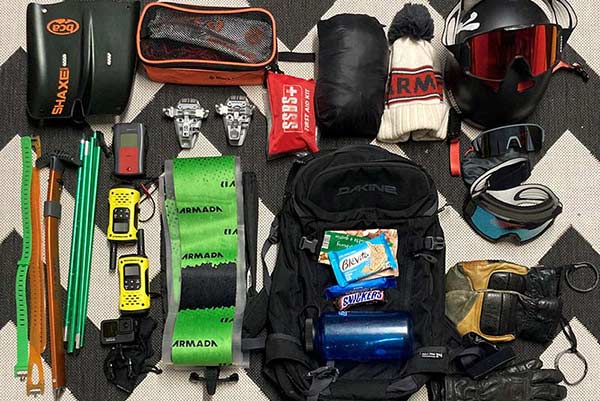
So that nothing is forgotten, you can prepare your material in peace and quiet the evening before. A checklist will help you think about the inconspicuous things. One approach can also be to imagine situations: you get up, what do you wear? Underwear, socks, pants, second layer, hat - you already have the material you need ready.
What happens during the lunch break? Pull out the thermos and drink tea, eat nuts, drink water and then enjoy the sandwich. And you already have your nutritional packing list in mind. The route has an exposed, steep and hard section, what are you doing there? Mount crampons, remove skis if necessary, put crampons on your shoes, shoulder or even untie skis, pick up an ice ax and, if necessary, rope up with your partner. Voilà, you know exactly what to pack for the tour.
The journey there and back
Once you have decided on a goal, you must first get to the starting point. That may sound banal, but anyone who blindly sets out from home could be in for a nasty surprise. Of course, traveling by public transport is the most ecological way. With very early starts – which is essential for spring tours in particular – the timetable often throws a spanner in the works.
A small side note: The starting time naturally also has an impact on the snow quality. The risk of wet snow avalanches increases with solar radiation. Note that you sometimes have to reserve buses and alpine taxis that require reservations for “the last mile”. Be sure to do it on time.
Anyone arriving by car should find out whether the roads are passable in winter and whether parking spaces can or may be used. Also keep in mind that your departure route offers fewer alternatives if you arrive by private transport. Unless, of course, you plan to return to your car by public transport.
For maximum relaxation, you should calculate enough time buffers anyway. Nothing is more annoying than starting a tour in a traffic jam or missing a connecting train. If you have a long journey to and from the destination, an overnight stay is always worth considering.
The Tour
It's finally starting. The skins are mounted, the avalanche transceiver checked and the group is ready to go. And now? Just steer towards the summit and then drive down? For maximum enjoyment, you need something more. Teamwork is in the foreground. The most important question before the start: Does everyone feel ready? Anyone who sets off with a bad feeling right from the start will hardly be able to enjoy the day.
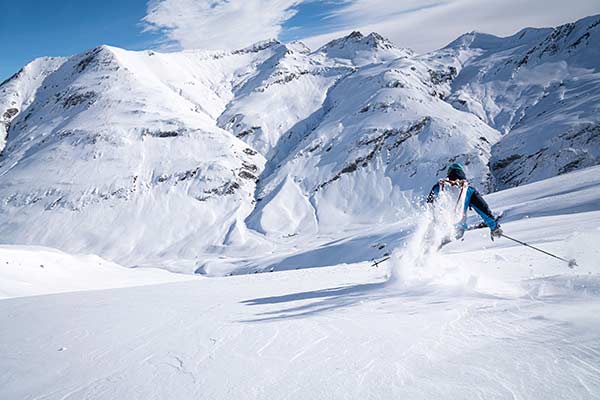
Communication is the be-all and end-all. Talk to each other. Not only about practical matters like analyzing slopes, but also about moods and feelings. If a member is upset or has doubts, you should be able to talk about it and find solutions. Always adapt to the weakest and, in an emergency, decide to cancel the tour.
A demolition should be discussed from the beginning anyway. You can solve this pragmatically, for example, by setting checkpoints. These can be guide values such as "we start the descent at 12:00 noon, regardless of whether we are on the summit or not".
The conclusion
Anyone who invests in a tour is not only safer, but also has more fun doing it. The world of ski touring and winter mountaineering is beautiful, but also complex. A solid basis, which comes about through education and experience, is essential. If you also pay attention to details, you will be able to enjoy the day on the skis even more.
You might also like
- New wildlife areas and wildlife sanctuaries | 2021
- Tip: This is how you choose the optimal ski length
- Rope or not rope? Backup options at full speed
About Bächli mountain sports
Bächli mountain sports is the leading Swiss specialist shop for climbing, mountaineering, expeditions, hiking, ski touring and snowshoeing. At currently 13 locations in Switzerland, Bächli Bergsport offers its customers expert advice and high-quality service. Published on LACRUX Bächli mountain sports periodically exciting contributions to the topics climbing, bouldering and mountaineering.
+ + +
Credits: Cover picture Henrik Morkel, text Bächli mountain sports


